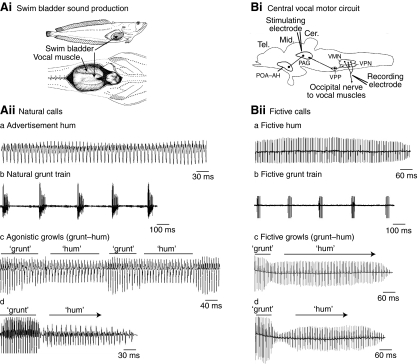Fig. 1.
Natural and fictive vocalizations of midshipman fish (Porichthys notatus). Note that time scales differ between natural and fictive calls to allow visualization of more complex waveforms in natural calls. (Ai) Vocalizations are produced by the simultaneous contraction of a pair of vocal muscles attached to the lateral walls of the swim bladder [modified from Bass et al. (Bass et al., 2008)]. (Aii) Representative natural calls of parental, type I male. (Aiia) The advertisement hum has sound pulses produced at a highly regular frequency for the entire duration of the call, ∼400 ms to >1 h. (Aiib) Agonistic grunt trains are repetitions of brief grunts at a rate of 1.5–3 Hz. (Aiic,d) Agonistic growls are the most complex vocalization with amplitude and frequency modulation. They are an amalgam of brief grunts (∼50–150 ms) and longer duration, multiharmonic hums and range from 300 ms to several seconds in duration. The grunt portion of the call in Aiid is clipped in the original recording because of the proximity of the fish to the hydrophone. (Bi) Sagittal view of the central network responsible for vocal production [modified from Bass and McKibben (Bass and McKibben, 2003)] (for details, see Bass et al., 1994; Goodson and Bass, 2002). Stimulation in the midbrain periaqueductal gray (PAG), which receives afferents from the forebrain preoptic area and anterior hypothalamus (POA–AH) and projects to the hindbrain/spinal vocal pattern generator (VPP–VPN–VMN), evokes fictive vocalizations that are recorded from the occipital nerves that innervate each vocal muscle. (Biia) Fictive hums also have a regular discharge frequency with average durations of 400 ms to 1 s. (Biib) Fictive grunt trains are repetitions of fictive grunts, like the natural call. (Biic,d) The fictive growl or `grunt–hum' averages 400–800 ms in duration. Other abbreviations for Bi: Cer., cerebellum; Mid., midbrain; Tel., telencephalon; VMN, vocal motor nucleus; VPN, vocal pacemaker nucleus; VPP, vocal prepacemaker nucleus.

